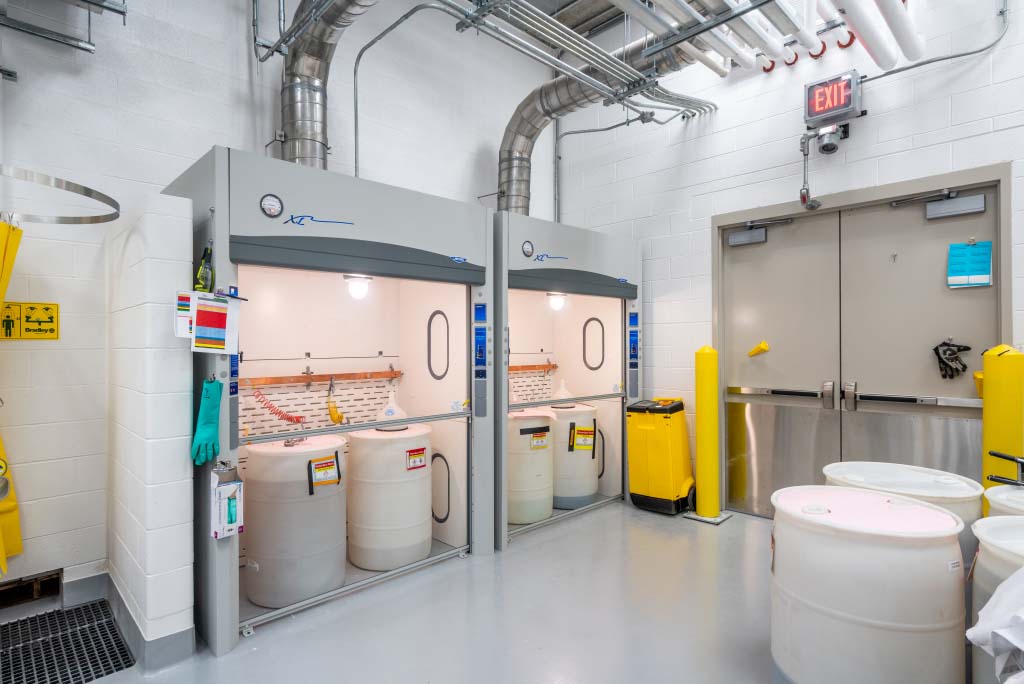Home » Floor-Mounted Fume Hoods: Features & Buying Guide
Floor-Mounted Fume Hoods: Features & Buying Guide
on August 19, 2025 in Blogs

Floor-mounted fume hoods represent the heavy-duty solution for laboratories dealing with large-scale chemical processes, aggressive chemicals, or bulky equipment that won’t fit under standard benchtop hoods. These standalone safety enclosures provide superior containment, increased workspace, and robust airflow capacity essential for demanding laboratory applications.
What Are Floor-Mounted Fume Hoods?
Floor-mounted fume hoods are laboratory safety enclosures that sit directly on the laboratory floor rather than atop lab benches. Also called floor-standing or ducted hoods, these units capture, contain, and exhaust hazardous fumes, vapors, and particulate matter during chemical processes.
Key Characteristics
High Airflow Capacity: Floor-mounted units deliver 1,000-1,500 cubic feet per minute (CFM) of airflow, compared to 400-800 CFM in standard benchtop models. This increased capacity maintains effective containment during high vapor-generating processes.
Spacious Work Area: These hoods offer deeper and wider work spaces, accommodating pilot-scale reactors, large distillation setups, or multiple analytical instruments simultaneously.
Robust Construction: Built for long-term exposure to aggressive chemicals using heavy-duty materials and construction methods that ensure reliable protection and lower maintenance costs.
Ducted Exhaust Systems: Connected directly to building HVAC systems through dedicated ductwork for safe contaminant removal from laboratory environments.
Safety Design: Despite their spacious design, users should never “walk into” these hoods; the sash barrier is essential for maintaining proper containment and user protection. A common misconception is that the large workspace allows for relaxed exhaust protocols, when proper ventilation practices are actually more critical with larger-scale operations.
What Features Should You Look For?
| Feature Category | Key Specifications | Why It Matters |
| Face Velocity | 80-120 fpm (standard setup) | Determines containment effectiveness and safety |
| Airflow Capacity | 1,000-1,500 CFM | Maintains containment during high vapor processes |
| Airflow System | VAV (energy efficient) or CAV (consistent) | Impacts energy costs and performance predictability |
| Interior Liner | Epoxy-resin, stainless steel, or phenolic resin | Chemical compatibility and durability |
| Work Surface | Epoxy resin, polypropylene, or stainless steel | Resistance to specific chemical classes |
| Sash Design | Vertical, horizontal, or combination | Balance between protection and accessibility |
| Safety Systems | Airflow monitoring, alarms, LED lighting | Early warning and safe operation |
| Service Integration | Gas, vacuum, electrical outlets | Convenience and containment integrity |
What Is the Optimal Face Velocity?
Optimal face velocity ranges from 80-120 feet per minute (fpm) as per the ASHRAE Manual. Face velocity measures the speed at which air enters the hood opening and determines containment effectiveness. The optimal range varies by application:
ASHRAE (American Society of Heating, Refrigerating and Air-Conditioning Engineers) recommends a face velocity range of 80-120 fpm (feet per minute) for fume hoods to ensure proper containment of hazardous substances. This range provides sufficient airflow to capture fumes while minimizing turbulence that could disrupt experiments or compromise containment. ASHRAE 110 testing, the industry standard for fume hood performance, includes face velocity measurement and smoke containment visualization.
Should You Choose VAV or CAV Airflow Systems?
The choice between Variable Air Volume (VAV) and Constant Air Volume (CAV) systems depends on your facility size, budget, and usage patterns. VAV systems can reduce energy costs by 30-50% but require more complex infrastructure, while CAV systems offer simpler, predictable operation at higher energy costs.
Variable Air Volume (VAV) Systems
- Energy Efficiency: Automatically adjusts fan speed based on sash position, saving 30-50% on energy costs when hoods operate at partial capacity
- Best For: Facilities with 4+ fume hoods in one room, new construction, or major renovations
- Requirements: Compatible HVAC infrastructure and sophisticated control systems
- Cost Structure: Higher upfront investment with long-term energy savings
- Advantage: Controls can optimize makeup air based on actual exhaust demand
Constant Air Volume (CAV) Systems
- Performance: Maintains steady, predictable suction regardless of sash height
- Best For: Labs with 1-3 fume hoods or limited exhaust requirements
- Requirements: Works with simpler facility infrastructure
- Cost Structure: Lower upfront costs but higher ongoing energy expenses
- Advantage: Consistent, reliable containment performance
Choosing VAV vs. CAV:
- Choose VAV when designing multiple hoods in new builds or renovations, where you can integrate advanced controls and optimize makeup air systems
- Choose CAV for smaller labs with fewer hoods and intermittent use patterns where simplicity and predictable performance are priorities
Which Construction Materials Are Best?
Interior liner materials should match your most frequently used chemicals: epoxy resin for organic chemistry, stainless steel for inorganic work, and phenolic resin for strong acids.
Interior Liner Options:
Epoxy-Resin Liners: Provide excellent general chemical resistance and cost-effectiveness for organic chemistry applications. Suitable for standard solvents, weak acids, and routine synthetic work.
Stainless Steel Liners: Offer superior durability for inorganic chemistry. Resistant to strong acids, bases, and high-temperature processes. Higher upfront cost but extended lifespan.
Phenolic Resin Liners: Excel with strong acids and high-temperature applications. Ideal for analytical labs or synthetic chemistry involving harsh conditions.
Work Surface Materials:
Epoxy Resin: Balance of chemical resistance and cost-effectiveness. Suitable for most general chemistry applications, including organic solvents (acetone, ethanol, methanol, hexane), dilute acids and bases, and biological work (except where aggressive sterilants are used frequently).
Polypropylene: Superior resistance to bases and alkaline solutions with excellent chemical resistance to oxidizers, acids, and bases. Contains no metal content, preventing corrosion issues. Nonporous and easy to clean, though softer than epoxy and more prone to scratching. Commonly used in acid digestion labs, corrosive storage cabinets, and fume hoods for trace metals analysis, where metal contamination must be avoided.
Stainless Steel: Ultimate durability and universal chemical compatibility for the most demanding applications.
Material Selection Guidelines
A common mistake is choosing epoxy for applications requiring trace metal analysis or frequent exposure to strong oxidizers, where polypropylene’s metal-free composition and superior chemical resistance are essential. Consider polypropylene when metal contamination is a concern or when working with aggressive chemicals that may compromise epoxy surfaces over time.
What Safety Features Are Essential?
Essential safety features include airflow monitoring systems, appropriate sash design, shadow-free LED lighting, and integrated service connections.
Airflow Monitoring Systems: Continuously track face velocity and provide visual/audible alarms when airflow drops below safe levels. Early warning prevents gradual containment failures that could expose personnel to hazardous vapors.
Sash Design Options:
- Vertical sashes: Maximum protection when closed, limited equipment access
- Horizontal sashes: Better accessibility, partial protection when open
- Combination sashes: Balance protection and access with higher cost
Integrated LED Lighting: Shadow-free illumination across entire work surface enables clear observation of reactions and identification of potential hazards.
Service Integration: Built-in gas lines, vacuum systems, and electrical outlets eliminate external connections that could compromise containment.
Chemical Hygiene Plans: Often overlooked during specification, a comprehensive chemical hygiene plan distributed by your EHS officer to lab technicians is essential for safe fume hood operation. This plan should outline proper usage protocols, emergency procedures, and maintenance requirements specific to your facility’s chemical processes.
How Do You Choose the Right Hood?
How Do You Assess Your Needs?
Document typical processes, including batch sizes, chemical types, equipment dimensions, and usage frequency, to determine appropriate hood specifications.
Key Assessment Factors:
- Maximum equipment dimensions requiring containment
- Typical batch sizes and reaction scales
- Chemical aggressiveness and vapor generation rates
- Frequency of hood use and number of operators
- Future expansion or process changes
What Infrastructure Do You Need?
VAV systems require compatible ductwork and HVAC controls, while all installations need adequate structural support, utilities, and proper ventilation capacity.
Infrastructure Requirements:
- HVAC system compatibility and capacity
- Ductwork sizing and routing requirements
- Electrical supply for controls and monitoring
- Structural support for hood weight plus equipment
- Utility connections (gas, vacuum, water, electrical)
What Are the Total Costs?
Total ownership costs include purchase price, installation, annual energy consumption, maintenance, and recertification over the hood’s 15-20 year lifespan.
Cost Components:
- Initial purchase and installation costs
- Ductwork modifications and facility upgrades
- Annual energy consumption (significant for CAV systems)
- Regular maintenance and recertification
- Filter replacements and service contracts
What About Installation and Operation?
How Often Should You Test Performance?
Annual recertification by qualified technicians is a minimum, with immediate evaluation needed if performance issues arise.
Recertification Testing Includes:
- Face velocity measurements across the sash opening
- Smoke testing for containment verification
- Alarm system functionality checks
- Airflow pattern visualization
- Control system calibration
How Can You Reduce Operating Costs?
VAV systems, proper sash management, regular maintenance, and LED lighting significantly reduce operational costs.
Energy Saving Strategies:
- Close sashes when hoods are not in active use
- Regular filter maintenance to prevent airflow restrictions
- VAV system installation where compatible
- LED lighting retrofits for existing hoods
- Airflow optimization during annual recertification
How Do You Maintain Performance?
What Maintenance Is Required?
Regular filter changes, airflow verification, component inspection, and annual professional service ensure continued safe operation.
Monthly Technician Checks:
- Visual inspection of sash operation and seals
- Lighting functionality and illumination quality
- Control system responsiveness and alarm testing
- Work surface condition and chemical damage assessment
Annual Professional Service:
- Complete airflow mapping and face velocity verification
- Filter replacement and system cleaning
- Calibration of monitoring and alarm systems
- Structural inspection for chemical damage or wear
Regular performance monitoring ensures hoods continue providing reliable protection while operating efficiently. Modern monitoring systems alert technicians to gradual performance degradation before it becomes a safety concern.
Key Takeaways
Floor-mounted fume hoods represent significant investments in laboratory safety and capability. Proper selection based on workflow requirements, facility infrastructure, and chemical compatibility ensures years of reliable service while protecting personnel from hazardous exposures.
When properly specified, installed, and maintained, these hoods become essential safety infrastructure that enables confident, effective work with hazardous materials. The investment in quality equipment pays dividends through improved safety, increased productivity, and reduced long-term operational costs.
Need guidance?
For those looking to integrate high-performance floor mount fume hoods into their laboratory operations, having the right expertise and equipment is crucial. Specialty Solutions provides precisely engineered, laboratory-grade fume hoods designed to meet rigorous safety and performance standards. Whether you need chemical fume hoods, perchloric acid hoods, radioisotope hoods, or custom ventilation solutions, our experts can help you find the ideal system for a safe, compliant, and efficient laboratory environment. For expert guidance on fume hood selection and our specialized ventilation solutions, complete the form below to get in touch with us.
FAQs
Perchloric acid requires a minimum of 115 fpm face velocity with specialized wash-down systems to prevent explosive perchlorate buildup. Standard hoods without wash-down capability should never be used for perchloric acid due to explosion risk from perchlorate buildup.
No, floor-mounted and benchtop hoods are fundamentally different designs requiring different structural support, ductwork, and floor space. Conversion isn’t feasible because these represent fundamentally different designs requiring dedicated floor space, independent structural support, and appropriately sized ductwork.
Monitor face velocity readings, observe smoke test patterns, and watch for containment issues during normal use. Monitor face velocity readings consistently, observe smoke test patterns during maintenance, and watch for containment during normal laboratory use. Fluctuating readings, unusual air patterns, or difficulty maintaining containment warrant immediate professional evaluation.
VAV systems adjust airflow based on sash position for energy savings, while CAV systems maintain constant airflow for predictable containment. VAV systems reduce energy costs but require more sophisticated controls and compatible facility infrastructure. CAV systems provide more predictable containment but higher energy consumption.

